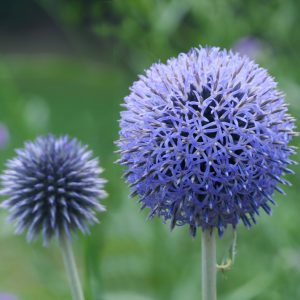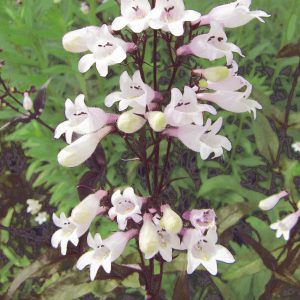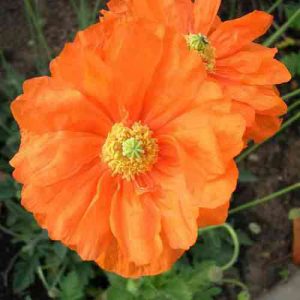- 1-9 pkts $4.50
- 10 pkts FREE
- Express post $12
Iris versicolor ‘Kermesina’
ROYAL FLAG IRIS
Iris versicolor ‘Kermesina’ has blooms of rich, deep, purple-red like royal velvet.
Blooms of rich, deep, purple-red royal velvet
With the petals delicately pencilled with white, and a gold blush at the throat.
Host of butterfly blooms
3-5 flowers are borne proud and tall on each branching stems. Hovering above a fans of upright grey-green sword foliage like flocks of elegant butterflies.
So the clump makes an arresting sight in late spring and early summer when in bloom.
Plus the foliage clump gives a strong architectural statement and colour contrast for many months.
Easy to please
Plant handsome Iris versicolor ‘Kermesina’ in Full Sun to Part Shade.
Unlike Bearded Iris, this Iris does not demand full sun all day.
It is perfectly happy in shade for part of the day.
Good as clay & boggy spots as well as garden loam
The wild Iris versicolor hails from North America where it is native to swamps and ditches as well as grassy meadows.
So versicolor is one Iris that gardeners with heavy clay soils and boggy spots can relish, or those with a dam or a ditch can plant along the edges. It can tolerate being inundated with up to 60cm. of water. So it is also popular as a pot plant to submerge in a pond.
But you don’t need a dam to grow it
However it does not need a permanently wet spot, and is equally as happy in average garden loam, as long as it get a good drink periodically.
A Royal Flag Iris
‘Kermesina’ is commonly called the Royal Flag Iris. “Royal” because of glorious colour of course. And “Flag” from an old English word “flagge” for rushes and reeds.
Good florists flowers
One branching stem with it’s multiple flowers fills a vase with elegant butterflies.
Frost hardy & low care
Iris versicolor ‘Kermesina’ is a deciduous Iris that forms a dense clump of tough rhizomes.
So it is easily able to cope with heavy frosts down to at least -20C.
It is also easy to grow & low maintenance, with virtually no trouble from pests or diseases.
The only work necessary is to tidy off spent flower stems after blooming, and to trim the clump after autumn ready for new spring growth.
‘Kermesina’ extends the spectacle of the Iris season.
Since they bloom after the Bearded Iris, and before the Japanese Iris.
Useful plant for First Nation Americans
The native Americans had many uses for this lovely plant.
Including rubbing their skin with the roots so the scent would warn off Rattle Snakes. But I cannot comment about the possible effects on our Tiger Snakes.
Though Native American tribes also used the plant as a laxative, diuretic, and anti-inflammatory; as a poultice for bruises and rheumatic joints; and also for easing skin irritations.
Resistant to rabbits and deer
However modern science tells us the Iris versicolor should only be eaten with great caution in small quantities. Because it does contain some toxic compounds.
Rabbits and deer clearly knew this all the time, as they leave Iris versicolor alone.
Iris versicolor is a deciduous perennial that forms a hardy clump of rhizomes.
It is tough and long lived.
90cm. High in flocks of bloom x 75cm. Wide clump of handsome grey-green sword-like foliage.
SEED SOWING ADVICE:
Sow in punnets indoors / or sow directly in the garden autumn or winter.
INDOORS: First rub the seeds gently between your hands with some sharp sand (or you can use fine sandpaper) to score the seed case. Then soak seeds in warm (not boiling) water that has previously been boiled.
And leave stand in the cooling water for 24 hours.
Now drain the seeds and sow in a punnet on the surface of good quality seed raising mix.
And cover with grit/mix/sand/vermiculite to depth the same as the of seed’s diameter.
Place the punnet in a warm, well-lit position (not in direct sunlight).
Continue to keep the punnet moist at 16 to 21°C for 2-4 weeks.
Then wrap the moist, sown punnet in cling wrap or a plastic bag & place in the fridge (not freezer) for 4-6 weeks.
Now remove from fridge, unwrap punnet & place again in a warm, well-lit position.
Temperatures 12-21°C approx. are ideal for rapid and optimum germination.
Seedlings emerge within approx. 30 days.
But patience – do not discard punnet, as some seedlings may come later.
SEED COUNT: 5 seeds per pack approx. (Seeds of this unusual Iris are scarce).
Click here for Nursery Open Days & Open Gardens Information
https://www.gardivalia.com.au/open-gardens
Click here to go back to Seeds Shop
https://www.seedscape.net.au/shop/
Related products
-
Add to WishlistAlready In WishlistAdd to Wishlist
-
Add to WishlistAlready In WishlistAdd to Wishlist
-
Add to WishlistAlready In WishlistAdd to Wishlist
-
Add to WishlistAlready In WishlistAdd to Wishlist





